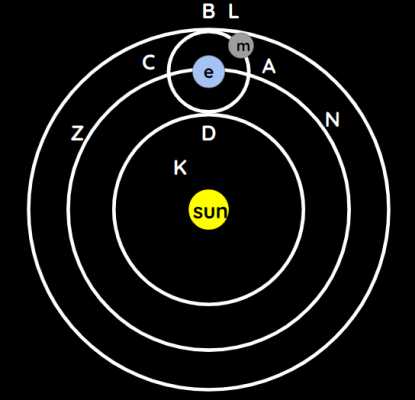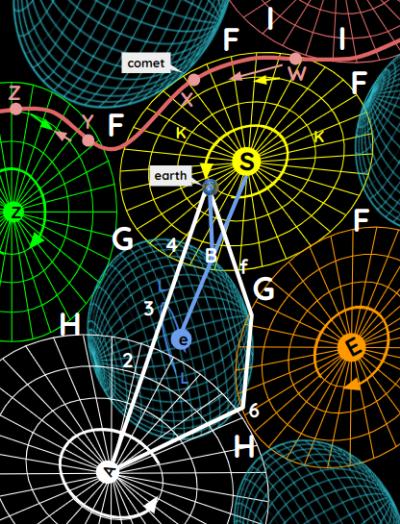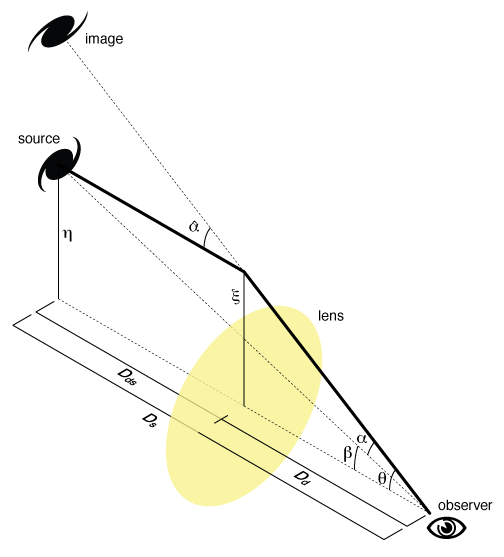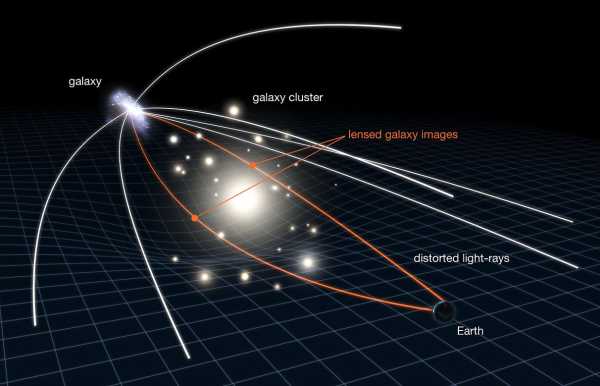The Aether and Gravitational Lensing
Table of Contents
How do the inhabitants of the aethereal Earth see their stellar gravitational territory as a whole like we physical Earthlings see our sky?
They see the sun as completely full of light and like our sun. It sends rays from all points of its surface toward their eyes. Because it is much closer to them than the stars, it must appear much larger to them.

The planetary gravitational territory ABCD turns around the Earth.
- Its air-aether offers some resistance to those rays from the sun.
All the parts of the stellar gravitational territory that are between sun and D strengthen the rays.
- The planetary gravitational territory between
Dandeis comparatively smaller. - This is why it can remove only very little of the force of those rays.
Even all the action of the air-aether of the stellar gravitational territory FGGF is not enough to impede the rays of the many fixed stars from reaching the Earth.

The stellar gravitational territories are those with a sun or star at its center.
- Those territories can be rather unequal in size.
- But they must always be exactly of the same force.
- In this way, all the fire-aether in the line
SBmust tend as strongly towardseas lineeBtends towardsS. - This means that force of line
SBis the same as the force of lineeB
- In this way, all the fire-aether in the line
- But the force of line
earth-Bis less than the force ofeB.- This means the force of line
earth-Bcannot prevent lineeBfrom extending toearth
- This means the force of line
Likewise, Star A can extend its rays to earth
- The air-aether between
Aand2helps those rays more than the air-aether between4andearthresists them. - The air-aether between
3and4helps them no less than that between3and2resists them.
This is why the stars look disproportional and mixed up.
The stars never appear in their actual places.
For example:
- Star
eappears as if it were in the straight lineearth-B - Star
Aappears as if it were in the straight lineearth-4.
This is because the territories are unequal in size.
- The edges that separate them are arranged in a way that the rays that pass through them, from the stars toward the earth, always meet them obliquely, never at right angles.
This makes the light bend and undergo a great deal of refraction.
- I demonstrated this in the Dioptrics
- It causes them to pass much more easily through one side of the edge than through the other.
Those lines earth-R, earth-4, and ones like them are so extremely long compared to the diameter of the Earth’s orbit around the sun.
- This makes the Earthlings always see the stars as fixed in the firmament.
- This is why astronomers say that they cannot observe parallax in the stars.*
Translator’s Note: Descartes removes the strongest empirical argument against the Copernican system. If, that is, the earth makes an annual circuit about the sun at a distance sufficient to account for observed planetary phenomena, observations of the fixed stars made from opposite sides of the orbit should differ by some amount. No one had been able to ascertain any difference, nor would anyone do so until the 19th century. Descartes joined Galileo and other defenders by arguing away the point with reference to the immense distance of the fixed stars.
Gravitational Lensing
The same star can often appear in different places because of the different edges that divert its rays toward the earth.

For example, Star A appears simultaneously:
- in the line
earth-4because of the rayA-2-4-earth - in the line
earth-fbecause of the rayA-6-f-earth
This is similar to how objects are multiplied when one looks through glasses or other transparent bodies cut along several faces.

Stars appear much smaller than they are because of their extreme distance. This is why:
- most of them must not appear at all
- others appear only insofar as the rays of stars joined together render the parts of the firmament through which they pass a bit whiter. This is similar to:
- the stars which astronomers call “nebulous,” or
- the great belt of our heaven that the poets pretend to be whitened by the milk of Juno*.
*Translator’s Note: Among the startling telescopic discoveries announced by Galileo in his Copernican works of the 1610s was the composition of the Milky Way; magnification revealed it to consist of a huge number of separate stars.
Despite this, the less distant stars are about equal to our sun.
Edges
Generally, the bodies that send out stronger rays appear larger to the eyes of observers than the surrounding bodies with weaker ones.
- Consequently, such stars seem larger than the parts of their heavens that are nearby and equal to them [in size].
The refractions of the rays of stars take place at the surfaces FG, GG, GF and ones like them.
- Such rays can be curved in such a way that they greatly increase the stars’ size.
- Even when completely flat, those refractions increase the size.
Those surfaces are in a matter that is very fluid and that never ceases to move.
- It is very probable that this should always make the stars shake and quiver somewhat.
- Consequently, this would make the stars appear to scintillate and vibrate, just as ours do.
- This makes them appear a bit larger.
In this way, the moon appears larger when viewed from the bottom of a calm lake which is rippled by some wind.
Over time, those surfaces change a bit.
- Some of them even bend noticeably in a short time, even if this only happens when a comet approaches them.
After a long time, This makes several stars seem to:
- change a bit in place without changing in size, or
- change a bit in size without changing in place.
Some even begin suddenly to appear or disappear, just as one has seen happen in the real world*.
*Translator’s Note: The novae or ’new stars’ observed in 1572 and 1604 had much to do with the spread of Copernicanism and of opposition to it.
The planets and the comets that are in our sun’s territory are made up of earth-aether that can be so large as to resist the action of light.
- This is why they are made visible by the rays of the sun by reflection.
- This is similar to opaque objects in our room being visible to us throught the rays of a lamp.
The rays of a lamp are weakened the farther the objects are from it, in proportion to the size of the spherical surfaces they shine on.
- The resistance of the air also adds to the weakening.
- This makes the objects near the lamp more lit than those far from it
The rays of the sun, however, conserve their force with distance.
- They are even increasingly strengthened as they move away from the sun until they have reached the edges of its territory.
- This is because all of the air-aether of the sun’s territory tends towards the edges.
- In contrast to the objects lit by the lamp, the planets near the sun are just as lit by the sun as the farthest planets or comets.
Light is an action or disposition in objects [that is carried by the air-aether].
If the space where the sun is were totally empty, then its territory’s air-aether would continuously tend toward our eyes in the same way as when that light is pushed by its fire-aether (even with almost as much force).
There is no need for the Sun to act to shine to send its light to us. Pure space [air-aether] is all that is needed for us to see the light from the sun.
This might seem paradoxical.
The rotation of the planets makes them twinkle, but much weaker and in another way than the stars do.
- The moon does not rotate and so it does not twinkle.